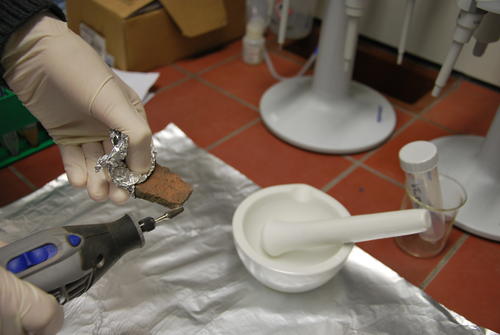The Content of Roman, Late Antique/Early Medieval Amphorae as Proxy of Economic Change and the Emergence of New Socio-Economic Networks
The analysis of the organic residues is conducted in collaboration with the Laboratory for Classical and Supramolecular Mass Spectrometry, BioSupraMol, Faculty of Biology, Chemistry and Pharmacy of the Freie Univ. Berlin.
Within the framework of my research focusing on Roman economy and Late Antique economic change, I use the potential of the GC/MS analysis of organic residues in amphorae with the aim of generating new proxies for the study of both transmarine and regional trade, circulation and urban / rural consumption patterns.
The focus is on the content of the Amphorae (oil, wine, garum, etc.) and on the economic implications of its reassessment and differentiation at a Mediterranean scale. The project includes several case studies from the Eastern and Western Mediterranean and the Red Sea, considering different regional topographic settings and settlement typologies/hierarchies (urban center, castrum, ecclesiastic site, villa, farm, village), with the aim of analyzing consumption patterns in relation to site topography and hierarchy. Furthermore, the role of the church as centre of trade and redistribution is an aim of the research project. The consumption patterns in ecclesiastic archaeological contexts are taken in consideration under this perspective.
To this respect one project's aim is the implementation of a geodatabase as dataset for modeling Late Antique Mediterranean trade networks using innovative computational methods (Collar et al. 2015).
The applied analytical procedure can provide new information to be compared to the traditional assumptions related to written and archaeological sources.
As a case in point, the debate about the nature of production and export of olive oil vs wine for example concerning North Africa i.e. African Amphorae which has been cross-fertilized by such an approach (Bonifay and Garnier 2007; Woodworth et al. 2015). The content of several transport containers produced in the Eastern Mediterranean (see for example the case of LR1 Amphorae, as oil and/or wine container: Mitchell 2005; Pieri 2005) is still debated. The content of African Spatheia - very small sized amphorae dating to the IV-VII c. AD - has been recently reassessed and the multifunctional nature of this container has been hypothesized (Pecci et al. 2010). Future analysis on the contents of the socalled Byzantine Globular Amphorae, recently typologically identified in the whole Mediterranean (VII-IX AD), will provide as well very relevant information on the continuity and transformation of Late Antique/Early Medieval transmarine trade and consumption and allows addressing aspects related to recycling and reuse of these multifunctional "packages"(Zanini 2010).
The analysis of the organic residues is conducted in collaboration with the Laboratory for Classical and Supramolecular Mass Spectrometry, BioSupraMol, Faculty of Biology, Chemistry and Pharmacy of the Freie Univ. Berlin.
Selected Bibliography
Collar A., Coward F., Brughmans T., Mills B. J., Networks in Archaeology: Phenomena, Abstraction, Representation, Journal of Archaeological Method and Theory, 2015, Volume 22, 1, 1-32
Bonifay, M., and Garnier, N. (2007), Que transportaient donc les amphores africaines?, in Papi E. (ed.), Supplying Rome and the Empire, Proceedings of an International Seminar (Siena 2004), Porthsmouth, Rhode Island, 9-31
Garnier, N. (2007), Analyse de résidus organiques conservés dans des amphores: un état de la question. In M. Bonifay and J. C. Tréglia (eds.), LRCW2. Late Roman Coarse Wares, Cooking Wares and Amphorae in the Mediterranean: Archaeology and Archaeometry, BAR International Series 1662: 39–58. Oxford: Archaeopress
Garnier, N. (2015), Methodologies d’analyse chimique organique en archéologie. In C. Oliveira, R. Morais and A. Morillo Cerdán (eds.): ArchaeoAnalytics. Chromatography and DNA analysis in archaeology, Município de Esposende, 13–39
Mitchell S. (2005), Olive cultivation in the economy of Roman Asia Minor, in Mitchell S., Katsari C. (ed.), Patterns in the Economy of Roman Asia Minor. Swansea: The Classical Press of Wales, 2005, 83-114
Pecci et al. (2010), Pecci A., Salvini L., Cirelli E., Augenti A., Castor oil at Classe (Ravenna- Italy): Residue analysis of some Late Roman Amphorae coming from the port, in LRCW3 (II), 617-622
Pecci et al. (2013), Pecci A., Giorgi G., Salvini L., Cau Ontiveros M. Á., Identifying wine markers in ceramics and plasters using gas chromatography–mass spectrometry. Experimental and archaeological materials, J. Archaeol. Sci. 40 (1), 109-115
Piéri, D. (2005) Le commerce du vin oriental à l’époque Byzantine. Beirut: , Bibliothèque d’Archéologie et d’Histoire. Institut Français du Proche Orient
Zanini, E. (2010), Forma delle anfore e forme del commercio tardoantico: spunti per una riflessione. LRCW3 (I), 139-148
Woodworth, M., Bernal, D., Bonifay, M., De Vos, D., Garnier, N., Keay, S., Pecci, A., Poblome, J., Pollard, M., Richez, F. and Wilson, A. (2015), The content of African Keay 25/Africana 3 Amphorae: Initial results of the CORONAM Project. In C. Oliveira, R. Morais and A. Morillo Cerdán (eds.), ArchaeoAnalytics. Chromatography and DNA analysis in archaeology, Município de Esposende, 41–57

